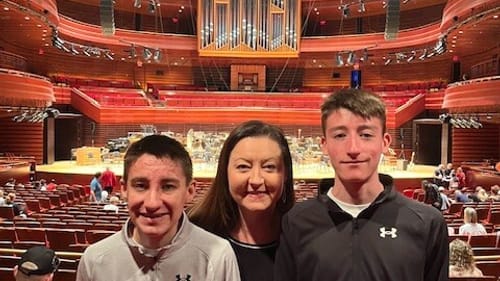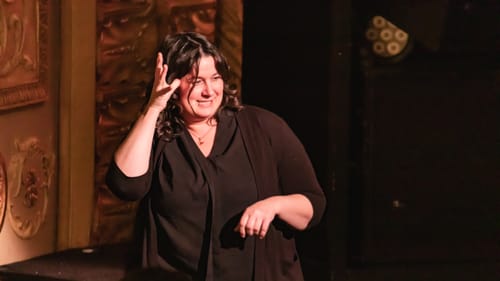Stay in the Loop
BSR publishes on a weekly schedule, with an email newsletter every Wednesday and Thursday morning. There’s no paywall, and subscribing is always free.
“We want to make every person in the diverse region feel welcome”
New accessibility options at Ensemble Arts open doors to audiences who are often excluded

Jaci Brown, who is Deaf and lives in Trenton, used to schlep to Broadway for ASL-interpreted performances, making plans months in advance, if she wanted to truly enjoy a musical show.
When she attended shows closer to home with her hearing friends, she knew she wasn’t getting the whole story.
“I would be sitting there, watching it, thinking: the show is good, but I’m not getting the lines, the content of the story. It’s fun to watch people dance and sing and move and react, but I’m not getting the full experience. I’m present, but not fully involved.”
That’s why Brown was thrilled to see that Ensemble Arts, which presents plays and concerts at the Kimmel Cultural Campus's Academy of Music and other venues, is boosting audience accessibility with ASL interpreters, audio description, Braille programs, and sensory-friendly performances.
For Brown, who majored in theater in college and now works for New Jersey’s Department of Human Services, those features matter. “I can pick from a list of shows [with ASL interpretation]. I can take my Deaf friends. I can see what the music sounds like.”
Reaching the widest possible audience
Each of the musicals presented by Ensemble Arts this year—& Juliet, Riverdance, The Wiz, Life of Pi, PAW Patrol Live!, and Beetlejuice—has one ASL-interpreted performance. PAW Patrol Live! also included a sensory-friendly performance, with house lights at mid-level instead of fully dark, a cool-down space, and sensory kits (containing a fidget spinner, noise-cancelling headphones, and a weighted beanbag) available for adults and children.
“Our mission is to share the transformative power of the arts with the widest possible audience,” says Crystal Brewe, executive vice president and chief marketing and experience officer for the Philadelphia Orchestra and Ensemble Arts. “We want to make every person in the diverse region feel welcome when they come through our doors.”
That’s also a pragmatic goal: an estimated one in four adults in the United States has some type of disability, and arts venues are still struggling post-pandemic to fill seats.
First time at the orchestra, but not the last
If a performing arts venue doesn’t take steps to expand and publicize its accessibility features, “you’re excluding families; they won’t consider attending,” says Victor Ykoruk, whose twin 15-year-old sons, Jack and Ryan, have autism.
Ykoruk’s wife, Bridget, had some trepidation about bringing the boys to the Children’s Halloween Spectacular last October, a sensory-friendly performance in which Philadelphia Orchestra members, in costume, played everything from Bach’s Toccata and Fugue in D Minor to the theme from Jaws.
One of their sons gets overwhelmed in crowds and is startled by bursts of applause. It helped, Ykoruk says, that the signage in Marian Anderson Hall was clear and the ushers trained to calmly guide families like his.
“There was guidance to check in, to obtain our tickets easily,” Ykoruk says. Orchestra leaders gave advance notice when the lights were about to dim or when the decibel level was going to swell. “They gave you a high sense of comfort that you knew how things were going to go.”

Ryan and Jack were dazzled by the venue, especially the atrium, Ykoruk says. Jack, who plays piano, recognized a few of the songs. He clapped along with others in the audience. And he did the repetitive gesture his parents call “flapping like a bird,” a clear sign that he’s excited and engaged. “Music takes him to that level,” Ykoruk says. “It’s not a bad thing.”
The Halloween Spectacular was the family’s “first toe in the water” to a Center City performance. But it won’t be their last. Ykoruk says sensory-friendly shows “are providing an amazing experience for individuals who might not normally have that opportunity.”
“It doesn’t matter if you can’t hear”
Arya Harding, 16, is a student at the Delaware School for the Deaf and a self-described Hamilton fanatic who has watched the film capture of the original stage show multiple times. But she was still wowed by the live, ASL-interpreted performance her class saw last fall at the Academy of Music. “When I went into the theater … there was a lot more action and the energy was just everywhere, all over the place. I really liked that.”
Her classmate, Armani Collins-Heath, 15, also loved the play and found herself singing the songs for weeks afterward. “Theater is for everyone,” she says. “People should be equal; it doesn’t matter if you can’t hear.”
Who is welcome?
Brewe, at Ensemble Arts, says training for ushers and other staff is part of the equation because the theatergoing experience matters as much to audience members as the art onstage: “Were you warmly welcomed? Did you feel included? Did you feel people were glad you were here?”
Those questions resonate for Lynette Mattiacci. Both she and her husband are Deaf; their three children, now 20, 17, and 15, are hearing and fluent in both ASL and spoken English. The family lives in Lansdale and attends four or five ASL-interpreted shows a year in Philadelphia.

Mattiacci appreciates the section designated for Deaf and hard-of-hearing patrons at the Kimmel Cultural Campus: an area close to the stage with clear sightlines for watching the interpreters.
“The arts provide opportunities to expose our kids to different perspectives and opinions, different ways of thinking. People are surprised to hear that I like music; of course, I like music! As a Deaf person, I would say equal access is critical.”
Exactly what we need
Through work with community partners, including the Eagles Autism Foundation, interpreters at Hands Up Productions, and Art-Reach, a nonprofit that connects the disability community and the arts, Ensemble Arts will continue to expand accessibility, looking at everything from wheelchair access in older venues to ways of publicizing ASL-interpreted shows.
“This is the kind of mission where you’re never necessarily done,” Brewe says. “Art is about bringing people together, about unifying, about building empathy and understanding. Given where the world is, it’s exactly what is needed right now.”
Editor’s note: Check below each BSR review for accessibility information about the individual shows we cover, including wheelchair access at venues, captioning, ASL interpretation, relaxed performance dates, and more.
Sign up for our newsletter
All of the week's new articles, all in one place. Sign up for the free weekly BSR newsletters, and don't miss a conversation.

 Anndee Hochman
Anndee Hochman